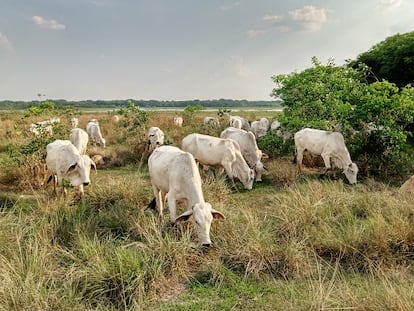Bolivian women unite to fight wildfires
The ladies of Chiquitania have formed firefighting squads and tree-planting teams to protect communities challenged by an increasingly hot and dry climate
Marina Justiniano became a firefighter in 2019 when she was already over 60. She helped combat devastating wildfires in the Chiquitania region of Bolivia. As president of the local indigenous women’s group, Justiniano is a respected community leader and a certified firefighter, one of the first to complete the training. “Year after year, we deal with fires. But often, the men aren’t around because they’re busy putting out fires in other places,” said Justiniano. Despite her age, she kept at it. “To show the other women that we can pitch in as well.” Now there are five women in her squad.
Justiniano and her friends live in villages in Roboré municipality, in the Chiquitania region (southeastern Bolivia). That area boasts the world’s largest and best-preserved tropical dry forest, but it’s at risk due to the climate crisis. Rising temperatures in Roboré, reaching 107°F (42°C) last year, increase the threat of wildfires. The local slash-and-burn tradition (chaqueo) for soil fertilization adds to the fire risk, as does the burning of garbage. When fires break out, the firefighting squad coordinates its plan of attack via a phone chain. Justiniano loads her backpack with 20 liters of drinking water, and grabs her helmet, flashlight, shovel, rake and machete. If the fires are burning on the ground, Justiniano and her team dig trenches and shovel dirt to smother the fires.
Almond trees are an effective firewall
Many trees in the dry forest easily catch fire, except for the local variety of almond trees (dipteryx alata). Thanks to its thick bark, this native species survives forest fires well and bounces back quickly. Nardy Velasco’s hopes to plant this tree everywhere. “I want every home to have an almond tree.” As a climate-resilient species, it can endure droughts and offer shade. Growing 14-50 feet tall, it’s great for post-fire reforestation and enriches soils by taking nitrogen out of the air and fixing it in the earth. Known as the barú nut in other places, the chiquitana almond, as it’s called here, has strong roots in the region.
Nardy Velasco is the senior leader (cacique) of the indigenous communities in Roboré. She’s also responsible for land stewardship, development and the environment in her own community of San Manuel. Velasco sees great potential in the almond trees as a source of income. The almonds fetch $5 per kilo, which is more profitable than other cash crops. High demand for almonds in the U.S. and Europe also offers new markets and opportunities.
The chiquitana almond nut taste like a cross between a peanut and an almond. “The taste is addictive,” said Velasco, who has had an almond tree just outside her front door for a long time. But she didn’t realize its value until a few years ago during the pandemic. “We asked our grandparents for advice [about the pandemic], and they told us to turn to the land.” Amid the pandemic crisis, reliance shifted to local resources like medicinal plants and the chiquitana almond.
Velasco took a training course and learned that the nut is nutritious, full of protein and has other several health benefits. Suddenly, she looked at the tree in front of her house with a fresh perspective. “It’s like a friend... I think about it a lot,” she said. She often gazes at the tree from her hammock, finding solace. And she knows how useful it is for combatting the region’s rising temperatures, fires and the climate crisis.
That’s why she spends her time writing fundraising requests to foundations and organizations for help in purchasing seedlings. Velasco provides training on tree planting, care and harvesting. Maize and cassava can be cultivated among the younger trees, and the almond pulp can be used as livestock feed.
Almonds are versatile, and can be used to make milk, chicha, salted and candied almonds. Nardy Velasco’s favorite recipe is a spicy chicken dish with chiquitana almond sauce. Almonds aren’t part of the local diet yet, as the nuts were traditionally used as cattle feed. But change is on the way. Roboré is just getting started and hopes to make its first almond harvest in three years.
Sign up for our weekly newsletter to get more English-language news coverage from EL PAÍS USA Edition
Tu suscripción se está usando en otro dispositivo
¿Quieres añadir otro usuario a tu suscripción?
Si continúas leyendo en este dispositivo, no se podrá leer en el otro.
FlechaTu suscripción se está usando en otro dispositivo y solo puedes acceder a EL PAÍS desde un dispositivo a la vez.
Si quieres compartir tu cuenta, cambia tu suscripción a la modalidad Premium, así podrás añadir otro usuario. Cada uno accederá con su propia cuenta de email, lo que os permitirá personalizar vuestra experiencia en EL PAÍS.
¿Tienes una suscripción de empresa? Accede aquí para contratar más cuentas.
En el caso de no saber quién está usando tu cuenta, te recomendamos cambiar tu contraseña aquí.
Si decides continuar compartiendo tu cuenta, este mensaje se mostrará en tu dispositivo y en el de la otra persona que está usando tu cuenta de forma indefinida, afectando a tu experiencia de lectura. Puedes consultar aquí los términos y condiciones de la suscripción digital.
More information

Sustainable meat: Bolivia works to reform livestock operations that trigger deforestation

The perfect storm stalks Bolivia, the country most vulnerable to the climate crisis in South America
Archived In
Últimas noticias
Most viewed
- Alain Aspect, Nobel laureate in physics: ‘Einstein was so smart that he would have had to recognize quantum entanglement’
- Mexico’s missing people crisis casts a shadow over World Cup venue
- Why oil has been at the center of Venezuela-US conflicts for decades
- Trump clarifies who is ultimately in charge in Venezuela: ‘Me’
- Mexico seeks to shore up its defenses following US incursion in Venezuela








































